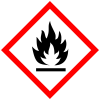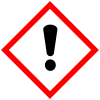All chemicals are labeled properly
Corrective actions:
Label all reagents, solutions, stocks, etc. with the appropriate name of the contents and hazard. Hazard information can be found in Section 2 of the Safety Data Sheet.
If abbreviations are used instead of full chemical names, make sure to provide an abbreviation chart in plain view in the lab. Chemical formulas are considered abbreviations.
We recommend adding the hazards to the abbreviation list to ensure key information is not missed on any secondary containers. It is also prudent to include chemicals you do not abbreviate but place in secondary containers regularly. Refer to the example below:
| Abbreviation | Chemical | Hazards |
|---|---|---|
| MeOH MOH |
Methanol |    |
| EtOH | Ethanol |   |
| PFA | Paraformaldehyde |     |
| Chloroform | Chloroform |    |
Note: If you see the symbol that a chemical is dangerous to health ![]() , check the SDS to see if it is a carcinogen and include that under hazards.
, check the SDS to see if it is a carcinogen and include that under hazards.
GHS hazards for chemicals can change by manufacturer (i.e. Ethanol is ![]()
![]() for many but
for many but ![]()
![]()
![]() for Acros).
for Acros).
MSU has developed a comprehensive guide for labeling of chemicals (PDF) in the laboratory that can be found on the EHS website.
In addition labels can be requested from EHS on the EHS Safety Portal (Lab Label Request).
Additional information:
PIs/supervisors must ensure that labels on incoming containers of hazardous chemicals for laboratory use are not removed or defaced. These original labels contain information on the identity of the chemical(s) in the container and the hazard identification of the chemical(s). It is recommended that incoming containers be labeled with the PI's name and date of receipt.
Labels on containers used for storing hazardous chemicals must include the chemical identification and appropriate hazard warnings.
If chemicals from commercial sources are repackaged into transfer vessels, the new containers must be labeled with all essential information on the original container.
Identifying the specific hazard associated with a chemical greatly reduces chances of misuse by regular laboratory employees, new users, or visitors to the laboratory. The label and SDS will indicate, for example, if a chemical is shock sensitive or explosive.
Groups of vials, small bottles or samples can be labeled as a group with a common ticket for all items. If the lab members wish to use abbreviations instead of the full chemical name, provide an abbreviation chart in plain view in the lab.
References:
- NIH Guidelines for Research Involving Recombinant or Synthetic Nucleic Acid Molecules. April 2019.
- MSU Chemical Hygiene Plan 3.4.1.1 (B) and 3.4.1.2 (A)
- OSHA Standard 1910.1450 App A.

